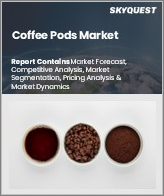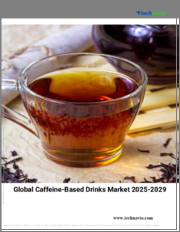
|
시장보고서
상품코드
1572548
무수 카페인 시장 : 기회, 성장 촉진요인, 산업 동향 분석 및 예측(2024-2032년)Anhydrous Caffeine Market, Opportunity, Growth Drivers, Industry Trend Analysis and Forecast, 2024-2032 |
||||||
세계 무수 카페인 시장은 2023년 19억 달러로 평가되었고, 2024년부터 2032년까지 연평균 5.2% 이상 성장할 것으로 예상됩니다.
에너지 증진 제품에 대한 소비자 수요 증가, 피트니스 및 웰빙 트렌드 증가, 카페인의 이점에 대한 인식이 높아지면서 이 시장의 성장을 견인하고 있습니다. 또한, 제품 제형의 혁신과 기능성 음료의 인기로 인해 시장 확대가 가속화되고 있습니다.
무수 카페인 시장의 주요 동향은 에너지 보충제 및 기능성 음료의 인기에 힘입어 이 성분에 대한 수요가 증가하고 있음을 강조하고 있습니다. 미국 식품의약국(FDA)은 지난 10년간 에너지 음료의 소비가 60% 급증했다고 지적하며 무수 카페인에 대한 수요 증가를 뒷받침하고 있습니다. 천연 및 유기농 제품으로의 전환으로 제조업체들은 이러한 추세에 맞추어 카페인 공급원 및 배합을 모색하고 있습니다.
카페인이 함유된 스낵, 첨단 배송 시스템 등 제품 혁신이 증가하는 추세입니다. 카페인의 효능에 대한 소비자의 인식이 높아지고 온라인 소매 채널이 확대되면서 시장 접근성과 성장 기회가 확대되고 있습니다. 미국 농무부(USDA)는 이러한 소비자 선호도를 반영하여 2023년 유기농 제품 매출이 25% 증가할 것으로 전망하고 있습니다. 이러한 추세는 건강 중심의 다양한 제품으로의 역동적인 시장 전환을 보여줍니다.
분말 분야는 예측 기간 동안 5.1% 이상의 CAGR로 성장하여 2032년까지 18억 달러에 달할 것으로 예상됩니다. 분말 분야는 다용도성과 다양한 용도로의 사용 용이성으로 인해 큰 잠재력을 가지고 있습니다. 무수 카페인 분말은 농축된 형태와 빠른 용해로 인해 영양 보충제, 에너지 음료 및 체중 관리 제품에 선호되고 있습니다. 이러한 적응성은 캡슐과 정제에서 분말에 이르기까지 다양한 제형에 정확한 용량 조절과 통합을 용이하게 합니다. 이 부문의 성장은 편리하고 맞춤형 에너지 솔루션에 대한 수요 증가, 건강 지향적인 소비자층의 확대, 보충제 공급 방식의 혁신으로 인해 더욱 가속화되고 있습니다.
무수 카페인 시장의 커피 원두 부문은 2032년까지 약 4.7%의 연평균 복합 성장률(CAGR)로 성장하여 시장 규모가 11억 달러에 달할 것으로 예상됩니다. 커피 원두는 1차 카페인 공급원으로서 시장에서 매우 중요한 역할을 하고 있습니다. 고품질 커피 원두는 카페인을 추출하기 위해 가공되어 영양 보충제, 에너지 음료 및 의약품에 적용하기 위해 무수 카페인으로 전환됩니다. 커피 원두의 원산지가 다양하기 때문에 추출되는 카페인의 품질과 특성도 다양합니다. 커피 재배의 성장과 추출 기술의 발전으로 커피 원두의 카페인 조달이 더욱 효율적이고 풍부해져 시장 확대와 기술 혁신을 촉진하고 있습니다.
북미 무수 카페인 시장은 2024년부터 2032년까지 5%의 연평균 복합 성장률(CAGR)로 성장하여 약 10억 달러 규모에 이를 것으로 예상됩니다. 에너지 증진 제품 및 건강 보조 식품에 대한 소비자의 강력한 수요가 이러한 성장을 주도하고 있습니다. 이 지역의 두드러진 피트니스 문화와 웰빙 트렌드가 시장 점유율 확대에 중요한 역할을 하고 있습니다. 무수 카페인은 에너지 음료, 운동 전 보충제, 체중 관리 제품 등에 광범위하게 사용되고 있습니다. 북미의 엄격한 식품 안전 기준은 제품의 품질을 높이는 동시에 시장 관계자들에게 도전이 되고 있으며, 전자상거래 플랫폼의 부상으로 무수 카페인 제품에 대한 접근성이 확대되고, 전략적 마케팅과 결합된 지속적인 기술 혁신은 이 지역의 건강 지향적 인 소비자의 공감을 불러 일으켜 시장 성장의 길을 열어줍니다, 시장 성장의 길을 열어줄 것입니다.
목차
제1장 조사 방법과 조사 범위
제2장 주요 요약
제3장 업계 인사이트
- 생태계 분석
- 주요 제조업체
- 유통업체
- 업계 전체 이익률
- 업계에 대한 영향요인
- 식이보충제 수요 증가
- 시장이 해결해야 할 과제
- 시장 기회
- 새로운 기회
- 성장 가능성 분석
- 제조 동향
- 기술 진화
- 지속가능한 제조
- 그린 프랙티스
- 탈탄소화
- 지속가능한 제조
- 원재료의 지속가능성
- 가격 동향(달러/톤), 2021-2032년
제4장 경쟁 구도
- 기업 점유율 분석
- 경쟁 포지셔닝 매트릭스
- 전략 전망 매트릭스
제5장 시장 규모와 예측 : 형태별, 2021-2032년
- 주요 동향
- 분말
- 과립
- 정제
제6장 시장 규모와 예측 : 유형별, 2021-2032년
- 주요 동향
- 합성 무수 카페인
- 천연 무수 카페인
제7장 시장 규모와 예측 : 원료별, 2021-2032년
- 주요 동향
- 커피원두
- 차잎
- 카카오콩
- 과라나
- 기타(e.g., kola nuts 등)
제8장 시장 규모와 예측 : 용도별, 2021-2032년
- 주요 동향
- 식품 및 음료
- 의약품
- 퍼스널케어 제품
- 식이보충제
- 기타
제9장 시장 규모와 예측 : 지역별, 2021-2032년
- 주요 동향
- 북미
- 미국
- 캐나다
- 유럽
- 독일
- 영국
- 프랑스
- 이탈리아
- 스페인
- 기타 유럽
- 아시아태평양
- 중국
- 인도
- 일본
- 한국
- 호주
- 기타 아시아태평양
- 라틴아메리카
- 브라질
- 멕시코
- 아르헨티나
- 기타 라틴아메리카
- 중동 및 아프리카
- 사우디아라비아
- 아랍에미리트(UAE)
- 남아프리카공화국
- 기타 중동 및 아프리카
제10장 기업 개요
- Caffeine Anhydrous, Inc.
- BASF SE
- Central Drug House(P) Ltd.
- Jayanti
- Spectrum Laboratory Products, Inc.
- Aarti Industries Limited
- CSPC Pharmaceutical Group Limited
- Cambridge Commodities Limited
- Kudos Chemie Limited
- Spectrum Chemical
The Global Anhydrous Caffeine Market was valued at USD 1.9 billion in 2023 and is set to grow at a CAGR of over 5.2% from 2024 to 2032. Increasing consumer demand for energy-boosting products, a rise in fitness and wellness trends, and growing awareness of caffeine's benefits drive this growth. Additionally, product formulation innovations and the popularity of functional beverages fuel market expansion.
Key trends in the anhydrous caffeine market highlight the escalating demand for this ingredient, driven by the popularity of energy supplements and functional beverages. The U.S. Food and Drug Administration (FDA) notes a 60% surge in energy drink consumption over the last decade, underscoring the rising demand for anhydrous caffeine. A shift towards natural and organic products leads manufacturers to explore caffeine sources and formulations that align with these trends.
Product innovations, such as caffeine-infused snacks and advanced delivery systems, are on the rise. Growing consumer awareness of caffeine's benefits and the expansion of online retail channels broaden market access and growth opportunities. Reflecting these consumer preferences, the U.S. Department of Agriculture (USDA) reported a 25% uptick in organic product sales in 2023. These trends highlight a dynamic shift towards diverse and health-centric offerings in the market.
The overall anhydrous caffeine industry is segmented based on form, type, application, source, and region.
The powder segment is projected to reach USD 1.8 billion by 2032, growing at a CAGR of over 5.1% during the forecast period. The powder segment boasts significant potential due to its versatility and ease of use across various applications. Its concentrated form and rapid dissolution make powdered anhydrous caffeine a favored choice in dietary supplements, energy drinks, and weight management products. This adaptability facilitates precise dosage control and integration into a wide array of formulations, from capsules and tablets to powders. The segment's growth is further bolstered by a rising demand for convenient and customizable energy solutions, an expanding health-conscious consumer base, and innovations in supplement delivery methods.
The coffee beans segment of the anhydrous caffeine market is projected to grow at a CAGR of around 4.7% through 2032, reaching a market size of USD 1.1 billion. Coffee beans play a pivotal role in the market as a primary caffeine source. High-quality coffee beans undergo processing to extract caffeine, which is subsequently transformed into its anhydrous form for applications in dietary supplements, energy drinks, and pharmaceuticals. The market benefits from the diverse origins of coffee beans, influencing the quality and characteristics of the resultant caffeine. With the growth of coffee cultivation and advancements in extraction technologies, sourcing caffeine from coffee beans becomes more efficient and abundant, driving market expansion and innovation.
North America anhydrous caffeine market is projected to reach a size of about USD 1 billion, growing at a 5% CAGR from 2024 to 2032. Robust consumer demand for energy-boosting products and dietary supplements fuels this growth. The region's pronounced fitness culture and wellness trends play a pivotal role in its substantial market share. Anhydrous caffeine finds extensive application in energy drinks, pre-workout supplements, and weight management products. While North America's stringent food safety standards bolster product quality, they also present challenges for market players. The rise of e-commerce platforms broadens access to anhydrous caffeine products, and continuous innovation paired with strategic marketing resonates with the region's health-conscious consumers, paving the way for further market growth.
Table of Contents
Chapter 1 Methodology and Scope
- 1.1 Market scope and definition
- 1.2 Base estimates and calculations
- 1.3 Forecast calculation
- 1.4 Data sources
- 1.4.1 Primary
- 1.4.2 Secondary
- 1.4.2.1 Paid sources
- 1.4.2.2 Public sources
Chapter 2 Executive Summary
- 2.1 Industry 360° synopsis
Chapter 3 Industry Insights
- 3.1 Industry ecosystem analysis
- 3.1.1 Key manufacturers
- 3.1.2 Distributors
- 3.1.3 Profit margins across the industry
- 3.2 Industry impact forces
- 3.2.1 Growth development in global electrical industry
- 3.2.2 Rising demand for sports and energy drinks
- 3.2.3 Wide utilization in pharmaceutical formulations
- 3.2.4 Growing demand for dietary supplements
- 3.2.5 Market challenges
- 3.2.5.1 Risk of cardiovascular issues and sleeplessness due to overconsumption
- 3.2.6 Market opportunity
- 3.2.6.1 New opportunities
- 3.2.6.2 Growth potential analysis
- 3.3 Raw material landscape
- 3.3.1 Manufacturing trends
- 3.3.2 Technology evolution
- 3.3.2.1 Sustainable manufacturing
- 3.3.2.1.1 Green practices
- 3.3.2.1.2 Decarbonization
- 3.3.2.1 Sustainable manufacturing
- 3.3.3 Sustainability in raw materials
- 3.3.4 Pricing trends (USD/Ton), 2021 - 2032
- 3.3.4.1 North America
- 3.3.4.2 Europe
- 3.3.4.3 Asia Pacific
- 3.3.4.4 Latin America
- 3.3.4.5 Middle East and Africa
- 3.4 Regulations and market impact
- 3.5 Porter's analysis
- 3.6 PESTEL analysis
Chapter 4 Competitive Landscape, 2023
- 4.1 Company market share analysis
- 4.2 Competitive positioning matrix
- 4.3 Strategic outlook matrix
Chapter 5 Market Size and Forecast, By Form, 2021-2032 (USD Billion, Kilo Tons)
- 5.1 Key trends
- 5.2 Powder
- 5.3 Granules
- 5.4 Tablets
Chapter 6 Market Size and Forecast, By Type, 2021-2032 (USD Billion, Kilo Tons)
- 6.1 Key trends
- 6.2 Synthetic anhydrous caffeine
- 6.3 Natural anhydrous caffeine
Chapter 7 Market Size and Forecast, By Source, 2021-2032 (USD Billion, Kilo Tons)
- 7.1 Key trends
- 7.2 Coffee beans
- 7.3 Tea leaves
- 7.4 Cocoa beans
- 7.5 Guarana
- 7.6 Others (e.g., kola nuts)
Chapter 8 Market Size and Forecast, By Application, 2021-2032 (USD Billion, Kilo Tons)
- 8.1 Key trends
- 8.2 Food and beverages
- 8.3 Pharmaceuticals
- 8.4 Personal care products
- 8.5 Nutraceuticals
- 8.6 Others
Chapter 9 Market Size and Forecast, By Region, 2021-2032 (USD Billion, Kilo Tons)
- 9.1 Key trends
- 9.2 North America
- 9.2.1 U.S.
- 9.2.2 Canada
- 9.3 Europe
- 9.3.1 Germany
- 9.3.2 UK
- 9.3.3 France
- 9.3.4 Italy
- 9.3.5 Spain
- 9.3.6 Rest of Europe
- 9.4 Asia Pacific
- 9.4.1 China
- 9.4.2 India
- 9.4.3 Japan
- 9.4.4 South Korea
- 9.4.5 Australia
- 9.4.6 Rest of Asia Pacific
- 9.5 Latin America
- 9.5.1 Brazil
- 9.5.2 Mexico
- 9.5.3 Argentina
- 9.5.4 Rest of Latin America
- 9.6 MEA
- 9.6.1 Saudi Arabia
- 9.6.2 UAE
- 9.6.3 South Africa
- 9.6.4 Rest of MEA
Chapter 10 Company Profiles
- 10.1 Caffeine Anhydrous, Inc.
- 10.2 BASF SE
- 10.3 Central Drug House (P) Ltd.
- 10.4 Jayanti
- 10.5 Spectrum Laboratory Products, Inc.
- 10.6 Aarti Industries Limited
- 10.7 CSPC Pharmaceutical Group Limited
- 10.8 Cambridge Commodities Limited
- 10.9 Kudos Chemie Limited
- 10.10 Spectrum Chemical

















